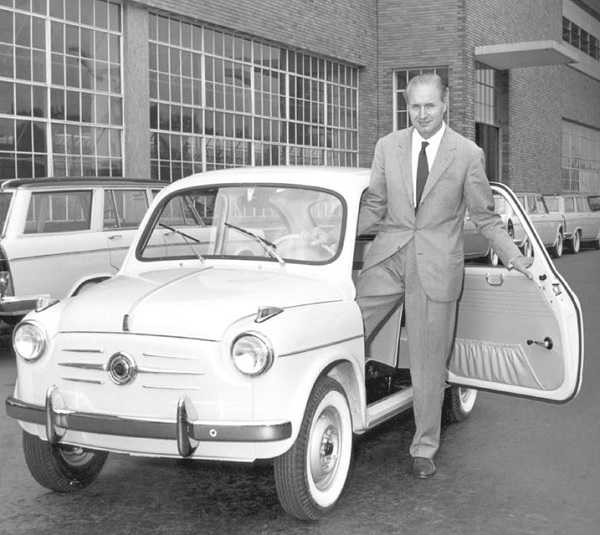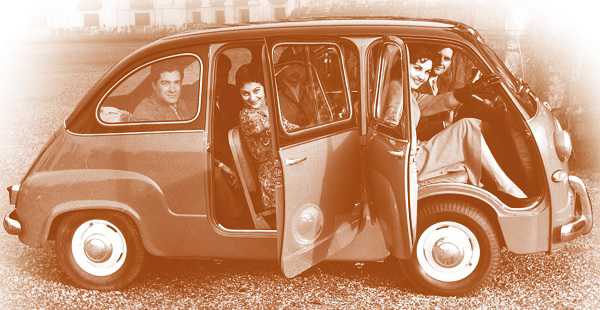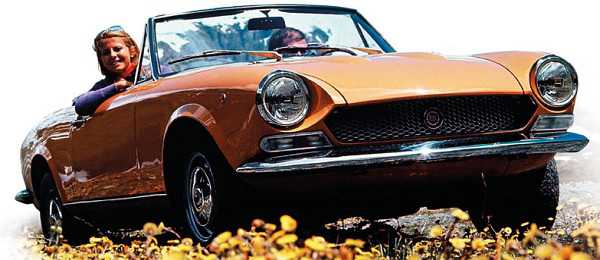Fiat (Fabbrica Italiana di Automobili Torino, or the Italian Car Factory of Turin) was founded on July 11, 1899, by Giovanni Agnelli, and quickly established itself in almost every automotive sector. Its specialty in small cars began in the 1930s, and continues today. The company has owned Ferrari and Lancia since 1969, Alfa Romeo since 1984, and Maserati since 1993.

FIAT BUILT ITS FIRST CAR, the 4 hp, in 1900, and in that year production averaged one car every two weeks. The impetus for growth came in 1903, however, when the company joined the Italian stock market and began manufacturing commercial vehicles. These found a ready market. By 1906, Fiat’s car range encompassed models extending from a modest 8 hp to a powerful 130 hp. Before long, its output was to include trams and marine engines.
Well before the outbreak of World War I (for which it produced aero engines and 20,000 lorries) Fiat was chasing the middle-class buyer with its affordable Zero model. In 1916, the company began construction of its enormous Lingotto plant outside Turin. With its rooftop test track (made internationally famous in the 1969 film The Italian Job), the Lingotto plant was the source of the big-selling 501 economy model, which was introduced in 1919.
In the 1920s Fiat launched the 519 luxury car, and broke new technical ground by pioneering mass-produced, aluminum cylinder heads. Starting in 1927, the company began switching all of its cars from right- to left-hand steering, and in 1929 the 514 became Fiat’s mainstream model.

Following on from many cars launched during the early 1930s, including the 508 Balila family car and the aerodynamic 1500 sedan, Fiat introduced its baby 500 Topolino in 1936. It was designed by Dr. Dante Giacosa and had a tiny, four-cylinder engine at the front. Its playful character earned it the nickname “Mickey Mouse.”
With two large factories at Lingotto and the newly built Mirafiori assembly site, Fiat was swiftly able to rebound after World War II, with a revised 500, the 1100, and 1500. With the debut in 1953 of the new, overhead-camshaft engine in the accomplished 1100 sedan, everyday Fiats gained a reputation for responsiveness (it also briefly made a super-sports car, the 8V of 1952).
Such responsiveness was less notable in the ponderous 1400, Italy’s first diesel-powered passenger car. Nonetheless it formed the basis of the Seat 1400, built under license in Spain by automaker SEAT (Sociedad Española de Automóviles de Turismo), helping Spain join the list of major automaking nations.
In 1955, once the Italian government had committed to a major road-building program, Fiat launched the 600 economy car, with its engine at the back. It was followed in 1957 by the immortal Nuova 500 city car, which also had its engine-an air-cooled twin-mounted in the rear. These vehicles would prove hugely popular throughout the 1960s, raising annual output from 425,000 to 1.7 million cars. Many small Italian sporting marques, especially Abarth, relied on Fiat for hardware, and this boosted the zesty reputation of Fiat’s cars still further.

The 1966 Fiat 124 sedan was a popular model and sold strongly. It formed the basis of the first VAZ/Lada in Russia, while in 1968 the 128 was the company’s first front-wheeldrive model; the spin-off 127 was among the first hatchback “superminis.” All three garnered European Car Of The Year awards. Meanwhile, the Fiat Dino sports cars used Ferrari engines, and the Fiat 130 was a new, large executive sedan and coupe. In 1976, Fiat opened a major new research center, and in 1978 introduced robotized manufacture to build the Ruitmo/Strada, which was intended as a rival for the Volkswagen Golf. As ever, though, it was in small cars that Fiat excelled. The box-shaped.
Panda of 1980 was followed by the ’83 Uno-a superlative family hatchback with global sales that exceeded 8 million. The car was later succeeded by the Cinquecento and Punto, while Fiat introduced the first direct-injection diesel engines (1987), first common rail diesel (1997), and first automated manual transmission (1999).
After almost 50 years at Fiat’s helm, Giovanni Agnelli died in 2003, his brother Umberto a year later. Then, in 2009, by signing a strategic alliance, Fiat became an unlikely savior of the American automaker Chrysler. The two companies had both withstood rollercoaster fortunes, but their futures were fused together in 2014 when Fiat-Chrysler Automobiles was formed, with the Agnelli family owning almost one-third of the merged automaking giant, the world’s seventh largest.
